October 20, 2023 Kerikeri (Day 22)
Today the weather finally arrived, off and on rain squalls and lots of wind. We stayed home, warm and dry and caught up on bookwork and webwork! I’ll take you back a few days to our walk along the Kerikeri river and give you some history of the area. Yesterday’s blog about the first mission in New Zealand is joined with today’s about the second mission established in New Zealand, again by Samuel Marsden. This mission was allowed and even requested by Hongi Hika, another Maori chief and uncle of Ruatara. He was the war chief of the Kororipo Pa (fortified hill village) that controlled the Kerikeri inlet nearby the Te Puna inlet controlled by his nephew.
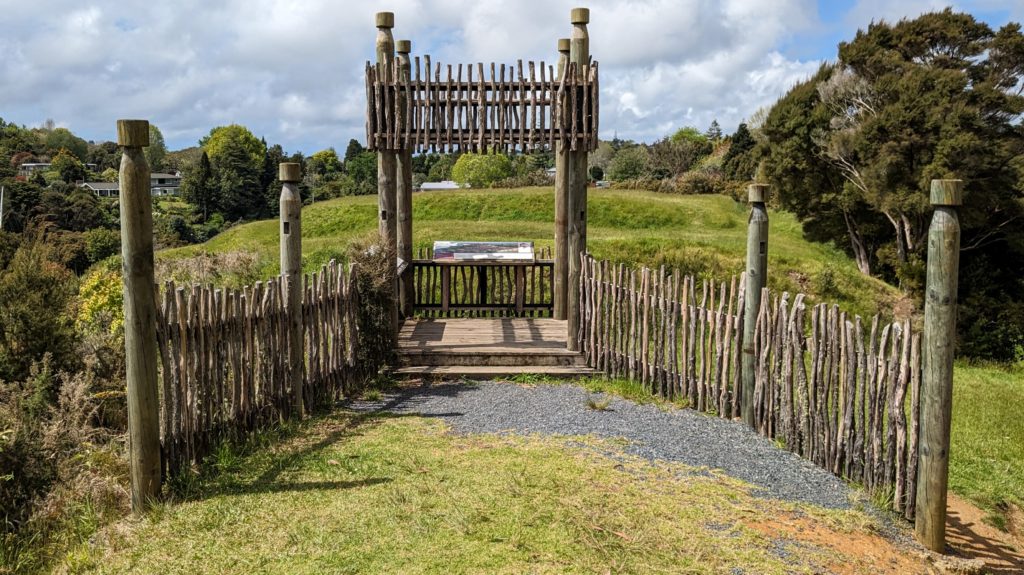
A recreation symbolizing the wooden post fortifications that protected the pa, The terraced hilltop is seen in the background.
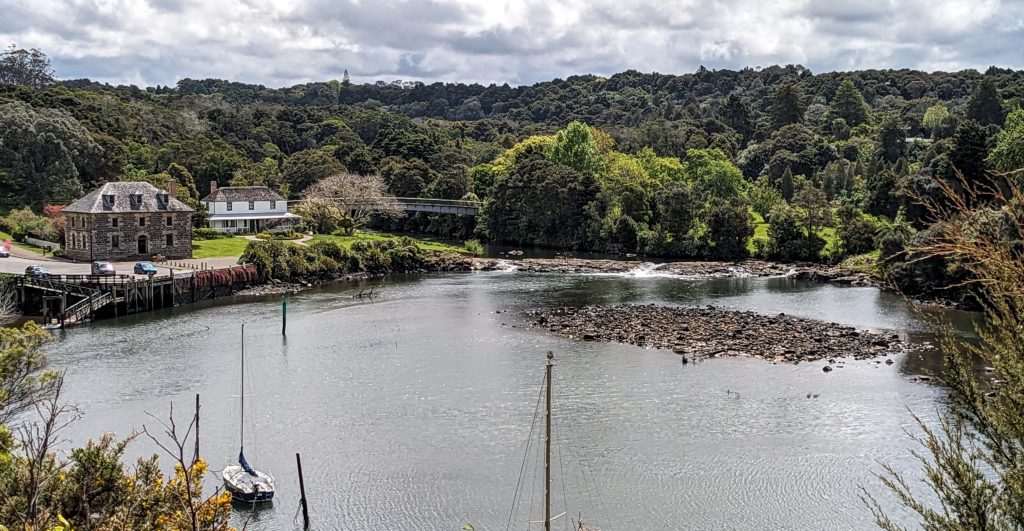
The inlet overlooked and was protected by Kororipo pa. Hongi Hika extended that protection to the mission established in 1822. The Stone Store was built between 1832 to 1836 and has been in continuous use since.

An impressive building!
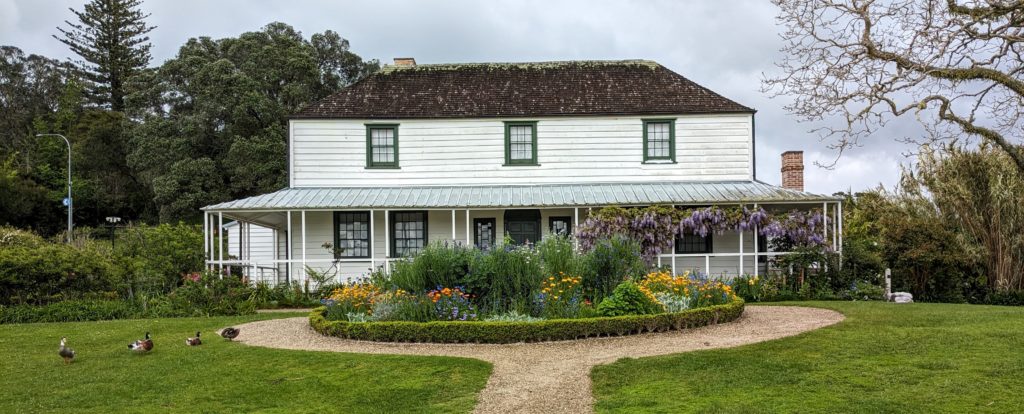
The Kemp House was built to house the missionary John Butler and family. They arrived in 1822, but left the next year after a falling out with Samuel Marsden. Later, missionary James Kemp and his wife & family moved in, eventually buying the property which stayed in the family until 1974 when it was gifted by the family to the NZ Historic Places Trust along with the gardens, orchards and the Stone Store. The house is the oldest surviving building in New Zealand!

We concluded that these benches between the Stone Store and the Kemp House are the oldest surviving benches in New Zealand!
October 19, 2023 Rangihoua Heritage Park (Day 22)
Another iffy day weatherwise, but we decided to go for it and explore the Purerua Peninsula, the north edge of Bay of Islands. Historically important as the first permanent settlement of Europeans in New Zealand-Aotearoa. We were surprised to drive on gravel roads through valleys and hills dotted with sheep and cattle.

Finally, a picture of New Zealand sheep! The white dots on the landscape. We couldn’t get any closer, they run away! This is the first area we have seen that has sheep predominantly. We’ve been seeing more cattle elsewhere.
We continued around the Te Puna inlet, aiming for the tip of the peninsula. The views were amazing! At one spot we could see today’s cruise ship in the bay, ‘The Brilliance of the Seas’.

From this view the cruise ship is hidden by Moturoa island in the left background, which blocks the view towards Russell and Paihia. On the right you can make out the buildings of “The Landing” winery and luxury resort.
We finally reached our destination. This depiction is probably circa 1820’s. The fortified hilltop (or pa) is named Rangihoua and was the home of the prominent chief Ruatara. He was a well traveled man, having signed onto whaling ships in 1805 and had many dealings with Europeans. He had an association with Samuel Marsden, an Englishman in Australia, a member of the CMS (Church Missionary Society) and chaplain to a penal colony in New South Wales, Australia. Their relationship led to the invitation by Ruatara to Marsden to set up a Christian Mission on his lands at the head of Te Puna inlet. After many delays Marsden was able to fulfill his desire to set up the mission in December 1814, “the first planned European settlement where Maori and Europeans learned to live side by side” (according to Tohu Whenua-Landmarks that tell our stories).
This depiction is probably circa 1820’s. The fortified hilltop (or pa) is named Rangihoua and was the home of the prominent chief Ruatara. He was a well traveled man, having signed onto whaling ships in 1805 and had many dealings with Europeans. He had an association with Samuel Marsden, an Englishman in Australia, a member of the CMS (Church Missionary Society) and chaplain to a penal colony in New South Wales, Australia. Their relationship led to the invitation by Ruatara to Marsden to set up a Christian Mission on his lands at the head of Te Puna inlet. After many delays Marsden was able to fulfill his desire to set up the mission in December 1814, “the first planned European settlement where Maori and Europeans learned to live side by side” (according to Tohu Whenua-Landmarks that tell our stories).

The current view. In the time of Maori settlement here the trees would have been removed and the hillside would have been dotted with housing, the terraced hilltop would be palisaded and well protected.
Looking back from the beach, the mission would have been built on terraces for housing, gardens, school house, chapel and utility buildings. Nothing but the terraces remain, with monuments and signage pointing out how life would have been in the early 1800’s here. A huge stone cross marks where the first Christmas Mass in New Zealand was held, two days after the new settlers arrived!

The Marsden Cross marks the spot. A terrace further up the slope is the cemetery of the settlement. Life was hard for the newcomers!

Tensions were common between the Maori (a name they began calling themselves, meaning ‘ordinary people’, after European contact) and the settlers. The Europeans were and still are, called Pakeha, non-Maori. The tensions rose for many reasons but mostly were due to different world-views on property rights and cultural practices.
After our long day we had a wonderful dinner of grilled flounder, again a benefit of our host’s freezer clearing!

A whole small flounder for each of us! And a fresh avocado for the salad and a fresh lemon for the fish, both from her garden!
October 18, 2023 Coastal Walkway Parts 3&4 (Day 21)
This morning I noticed there are ripening artichokes in our hosts front garden!

Artichokes with a bird of paradise in the background.
We decided today is the day to tackle the last 2 sections of the Coastal Walkway that we have not finished. From the Haumi river south to Paihia Road parking area and from the Haumi river north to the town of Paihia. We drove to the broad Haumi river parking area, fronting a big pebble beach that didn’t look too inviting for swimming, and headed south first.

This old tractor was at the edge of private property just yards from the bay.

The track passed through a little, neat & clean campground. Not too full yet.

Imagine waking up to this view out your camper window!

Robert spotted this floating jasmine flower, stuck to spider web maybe?
I wish I could describe the fragrance along most of the trails we have been on! Invasive introduced jasmine is rampant here and Australian frangipani has been introduced as well, among other flowers in profusion. Imagine walking through a perfume department full of tropical flower scents sprayed at you constantly! Sometimes it is overpowering and gives me a headache! We reached Paihia Road and hiked back to the Haumi river parking area. Heading towards Paihia next, we were walking along the bay, on sandy beach or rocks. It seems this route is best at low tide!

Heading to Paihia along the water.

Out in the bay we spotted the Grand Princess, the second cruise ship of the season, with potentially 3,122 passengers, anchored in the bay. From our B&B we can see the tenders bringing the passengers (money) into town. Our host suggested we avoid town on cruise ship days and gave us a list of the boats and their arrival days!
We reached Paihia and got a cappuccino and chai latte to power us back to the car! 4 miles total!
October 17, 2023 Rainbow Falls Track (Day 20)
We went to Kerikeri today to find and walk the Rainbow Falls Track. We discovered a lot of historical points of interest too, but I’ll save that for another day. Rain was predicted and we got a bit of it as we ate our savory muffin and drank our cappuccinos before we started our hike. It sprinkled a little as we walked, but we had our rain jackets at the ready!
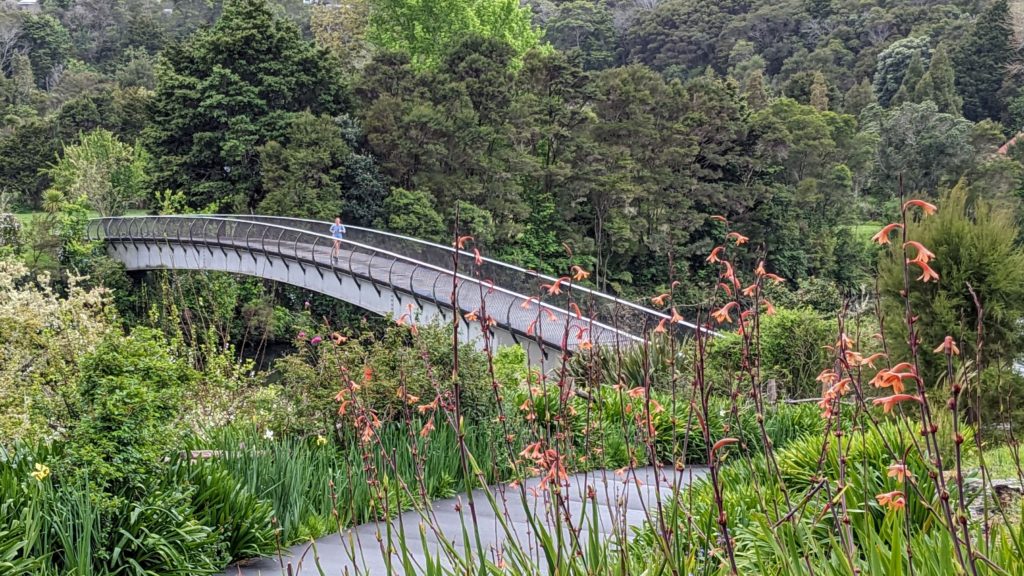
We crossed the footbridge from the historical area into the park where the Kerikeri river track started.

We encountered 2 huge trees covered in burls early on the trail!

The first waterfall, Wharapuke falls, was reached soon after.

The track continued through dark woods full of exotic huge plants, trees and moss covered rock slopes. Going under a highway overpass we saw these black-eyed susan vines, native to east Africa, covering trees and bushes.

Following a raised wooden walkway we finally approached Rainbow falls. Unfortunately the sun was not out so we didn’t experience the rainbow in the mist that it is known for.

The trail then went uphill to give us a view mid-way up the falls.
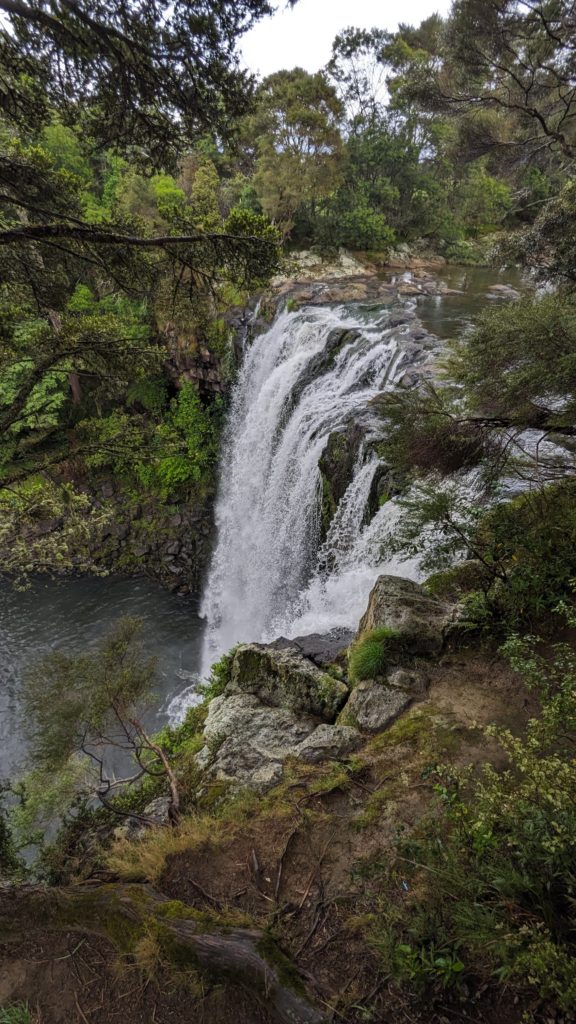
At the top several observation decks gave us views of the falls from the top.
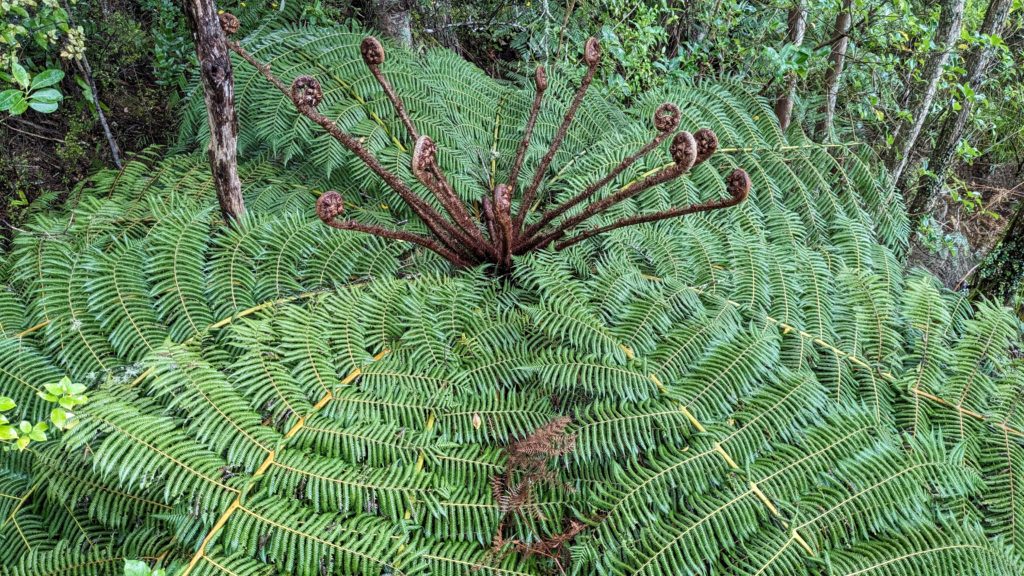
On the left of the deck we looked down at this tree-fern crown, with the new fronds uncurling in the mist from the falls, ready to soak up the sun when it finally comes out!
We retraced our hike back to the parking lot, enjoyed a picnic lunch as the sun came out and dried the grass. In the sun we finished exploring the historical areas, then returned home with a haul of groceries from the bigger store in Kerikeri, the hub of the agricultural community in Northland.
October 16, 2023 East of BOI (Day 19)
While the tire was being fixed we took a morning walk on part of the Waitangi track where we saw the Shag rookery from our first walk on the track on Oct. 4. Now the nests are filled with baby birds and the parents are busy ferrying back and forth from the estuary with crops full of food they regurgitate to the babies who stick their whole heads into the parents mouth! We think there are 2 species of ‘shags’ as cormorants are known here, the pied shag and one I can’t identify.
After the tire was fixed we started on our trip we planned for yesterday, taking the Opua car ferry across to Okiato and touring as much as we could on the peninsula on the east edge of Bay of Islands.
We stopped first at Waipiro Bay for the view!

No access to the beach here. This area is rural and agricultural, with vineyards and sheep+cattle stations.
We drove to the end of the road at Rawhiti, a small community with 2 Maori meeting houses (Marae). After this town is the long track to the Cape Brett lighthouse, 16.3km (10 miles) one way! Kaimarama Bay has a small beach looking out towards small islands and rocks where we stopped for our picnic lunch.

Looking left, from where we came.

Looking right towards other islands.
We backtracked to the first junction and headed south. We found a tiny bay with a protected beach, Te Akau Elliot Bay. We took our chairs and cameras and enjoyed the almost deserted beach.

Returning from our sojourn on the beach. I’m trying to get some color on those white legs!
Continuing south we headed down to North Head, of course to the end of the road!

The Whangaruru North Head campground was the end of the road.
Returning north we got fantastic views of the skinny peninsula.

Looking west across Whangaruru Harbour.

Looking north at Bland Bay, a small town (no services) that looks anything but bland! With Waiatapaua bay and the open ocean on the right, and Whangaruru harbour on the left.
We backtracked to Okiato and caught the car ferry back in the evening light. A great day of exploring!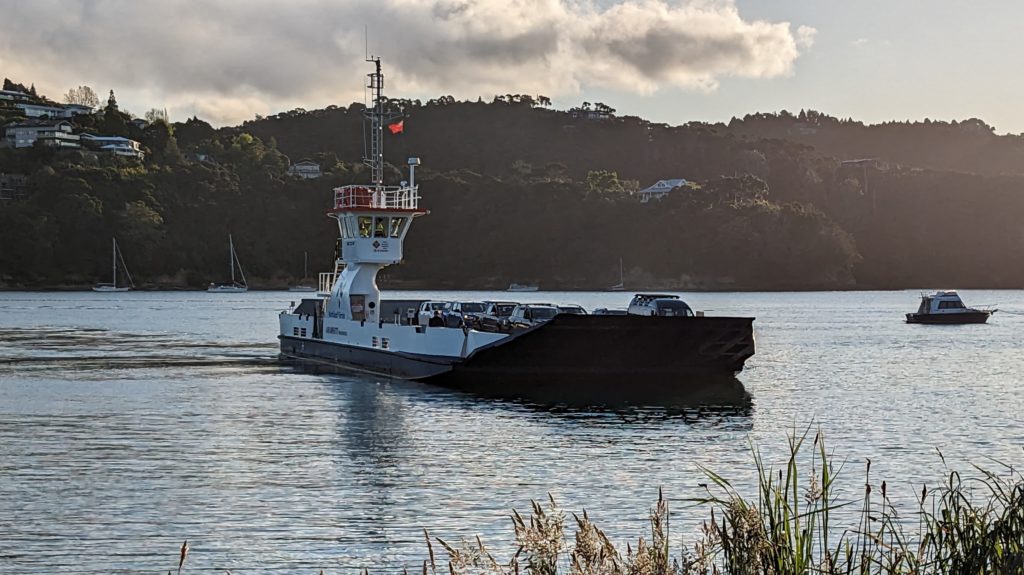








 This depiction is probably circa 1820’s. The fortified hilltop (or pa) is named Rangihoua and was the home of the prominent chief
This depiction is probably circa 1820’s. The fortified hilltop (or pa) is named Rangihoua and was the home of the prominent chief 

























